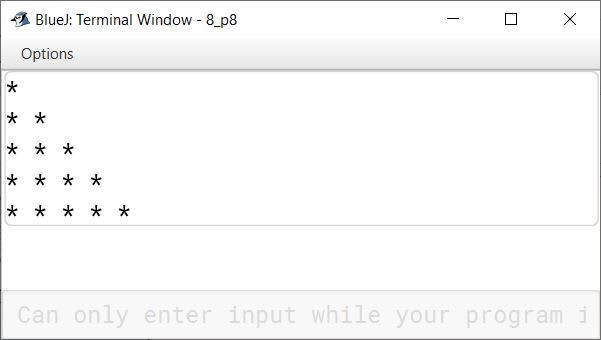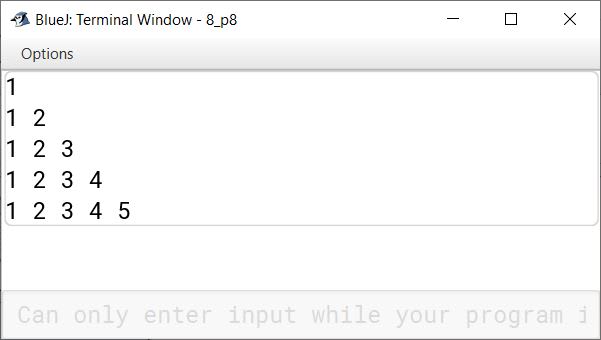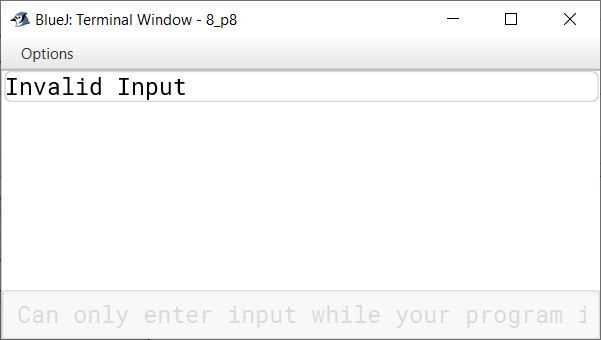Computer Applications
Define a class to overload the method generate() with the following variations:
void generate(int n, char ch) — Prints a pattern of n rows based on the value of
ch:- If
chis'*', print a pattern of stars (*).
n = 5
* * * * * * * * * * * * * * *- If
chis'N', print a pattern of numbers.
n = 5
1 2 2 3 3 3 4 4 4 4 5 5 5 5 5- For any other value of
chprintInvalid Input.
- If
double generate(int n) — Calculates and returns the sum of the following series:
1 - $\dfrac{1}{2}$ + $\dfrac{1}{3}$ - $\dfrac{1}{4}$ ….. to n termsdouble generate(double p, double q, double r) — Calculates and returns the value of z, where:
z = p2 + q2 - r2
public class KboatOverload
{
_______(1)_________ {
if (ch != '*'
&& Character.toLowerCase(ch) != 'n') {
System.out.println("Invalid Input");
}
else {
_______(2)_________
_______(3)_________
_______(4)_________
System.out.print("* ");
}
else {
System.out.print(i + " ");
}
}
System.out.println();
}
}
}
double generate(int n) {
int a = 1;
double sum = 0;
_______(5)_________
double t = _______(6)_________
t *= a;
_______(7)_________
a *= -1;
}
return sum;
}
_______(8)_________ {
double z = _______(9)_________
_______(10)_________
}
}
User Defined Methods
3 Likes
Answer
void generate(int n, char ch)for (int i = 1; i <= n; i++) {for (int j = 1; j <= i; j++) {if (ch == '*') {for (int i = 1; i <= n; i++) {1.0 / i;sum += t;double generate(double p, double q, double r)(p * p) + (q * q) - (r * r);return z;
Explanation
public class KboatOverload
{
void generate(int n, char ch) {
if (ch != '*'
&& Character.toLowerCase(ch) != 'n') {
System.out.println("Invalid Input");
}
else {
for (int i = 1; i <= n; i++) {
for (int j = 1; j <= i; j++) {
if (ch == '*') {
System.out.print("* ");
}
else {
System.out.print(i + " ");
}
}
System.out.println();
}
}
}
double generate(int n) {
int a = 1;
double sum = 0;
for (int i = 1; i <= n; i++) {
double t = 1.0 / i;
t *= a;
sum += t;
a *= -1;
}
return sum;
}
double generate(double p, double q, double r) {
double z = (p * p) + (q * q) - (r * r);
return z;
}
}
Variable Description Table
Method: void generate(int n, char ch)
| Variable Name | Type | Purpose |
|---|---|---|
| n | int | The number of rows to be printed in the pattern. |
| ch | char | A character that determines the type of pattern: '*' for stars, 'N' for numbers. |
| i | int | A loop variable used to iterate over the number of rows in the pattern. |
| j | int | A loop variable used to iterate over the number of elements in a particular row of the pattern. |
Method: double generate(int n)
| Variable Name | Type | Purpose |
|---|---|---|
| n | int | The number of terms in the series to be calculated. |
| a | int | A multiplier that alternates the sign of the series terms to create alternating addition and subtraction. |
| sum | double | Accumulated sum of the series terms to be returned as the result. |
| t | double | The current term in the series, calculated as 1.0/i and adjusted by a for the alternating pattern. |
Method: double generate(double p, double q, double r)
| Variable Name | Data Type | Purpose |
|---|---|---|
| p | double | The first component in the expression for z. |
| q | double | The second component in the expression for z. |
| r | double | The third component in the expression for z. |
| z | double | The calculated result of the expression z = p2 + q2 - r2, which is returned by the method. |
Program Explanation
Let's go through the Java program step by step to understand how it works:
Method 1: generate(int n, char ch)
1. Input Validation:
- The method takes two parameters: an integer
n(the number of rows) and a characterch(which determines the type of pattern). - The method initially checks if the character
chis neither an asterisk ('*') nor the letter'N'.- This condition is evaluated using
if (ch != '*' && Character.toLowerCase(ch) != 'n'). - If the character
chdoes not match'*'or'n', it prints "Invalid Input" and exits the method because the patterns are defined only for these characters.
- This condition is evaluated using
2. Pattern Generation:
- If
chis'*'or'N', the method proceeds to generate a pattern involving multiple rows, based on the numbern.
3. Nested Loop Construction:
Outer Loop:
for (int i = 1; i <= n; i++)iterates from 1 throughn, each iteration representing a new row of the pattern.- The value of
isignifies the current row number and dictates how many elements will be printed in that row.
Inner Loop:
for (int j = 1; j <= i; j++)iterates from 1 toi, determining the number of characters to be printed in thei-throw.- The inner loop runs precisely
itimes for each iteration of the outer loop, allowing for the growing number of elements in the pattern across consecutive rows.
4. Pattern Decision:
Star Pattern (
ch == '*'):- If
chis an asterisk ('*'), the inner loop prints a star followed by a space ("* "), usingSystem.out.print("* ");. - This creates a symmetric triangular pattern of stars with each row
ihavingistars.
- If
Number Pattern (
ch == 'N'):- If
chis the letter'N'(case-insensitive check is performed withCharacter.toLowerCase(ch)), the inner loop prints the current row numberirepeatedly,itimes, followed by a space. - Each element in the row is generated using
System.out.print(i + " ");. This creates a symmetric triangular pattern of numbers.
- If
5. Row Termination:
- After the inner loop completes its cycles for one row,
System.out.println();is used to move the cursor to the next line before continuing to the next iteration of the outer loop, presenting each row on a new line.
Method 2: generate(int n)
1. Initialization:
- The method initializes an integer variable
ato1. This variable is used to alternate the sign of each term in the series. - A
doublevariablesumis initialized to0. This will hold the accumulated sum of the series.
2. Iteration Over Terms:
for (int i = 1; i <= n; i++): The loop iterates from1ton. Each iteration corresponds to computing one term of the series.- The variable
irepresents the current term index in the series.
3. Term Calculation:
double t = 1.0 / i;: This calculates the reciprocal of the current indexi, which is the base value of the current term in the series.t *= a;: Multiplies the base value bya, effectively alternating the sign oft:- When
ais1, the term remains positive. - When
ais-1, the term becomes negative.
- When
- The alternation in signs achieves the series' structure of alternating addition and subtraction.
4. Accumulation of the Series:
sum += t;: Adds the current termtto the cumulativesum. Since the terms alternate between positive and negative based ona, the overall effect is an accumulation according to the series pattern.
5. Prepare for the Next Term:
a *= -1;: Flips the sign ofafor the next term. This ensures the alternation continues correctly through the iterations.
6. Return the Result:
- After the loop completes,
return sum;provides the final computed sum of the series tonterms.
Method 3: generate(double p, double q, double r)
- This method calculates the expression
(p * p) + (q * q) - (r * r). - It squares
pandq, adds these squares together, and subtracts the square ofrfrom this sum. - The result of this calculation is stored in the variable
z, which is then returned as the output.
Output



Answered By
2 Likes
Related Questions
Assertion (A): An argument is a value that is passed to a method when it is called.
Reason (R): Variables which are declared in a method prototype to receive values are called actual parameters
- Both Assertion (A) and Reason (R) are true and Reason (R) is a correct explanation of Assertion (A)
- Both Assertion (A) and Reason (R) are true and Reason (R) is not a correct explanation of Assertion(A)
- Assertion (A) is true and Reason (R) is false
- Assertion (A) is false and Reason (R) is true
Define a class to overload the method display() as follows:
void display(): To print the following format using nested loop.
1 2 1 2 1
1 2 1 2 1
1 2 1 2 1void display (int n, int m) : To print the quotient of the division of m and n if m is greater than n otherwise print the sum of twice n and thrice m.
double display (double a, double b, double c) — to print the value of z where
Which OOP principle implements method overloading?
Using switch statement write a menu driven program to overload a function series as follows:
(a) void series() — To find and display the sum of the following series:
S = 2 - 4 + 6 - 8 + 10 ….. - 20(b) void series(int n, int x) — To find and display the sum of the following series:
S = (x2 / 1!) + (x4 / 3!) + (x6 / 5!) + ……. to n terms